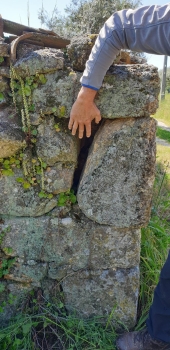It looks like it's built on a slope.
Where is the water coming in? Along the back where there's earth built up behind it? If so, you will probably have to dig it out and put some form of drainage in.
We had the same trouble here when we moved in last year. Here's my partner starting on the job of removing several feet of earth. Still have a way to go but we stopped for the winter in case we got trapped behind there if there was a minor land-slip of wet soil.

There's only a fairly narrow gap between the wall of the house and the terrace wall, which might look like earth but it's actually cut out of the rock. We don't like working behind there unless the soil on the terrace behind is very dry in case it slips when someone is behind there!
We only did half last year. The picture below shows the wall during heavy, prolonged rain where we have dug the soil out.
And this photo shows the side that still needs to be dug out...









